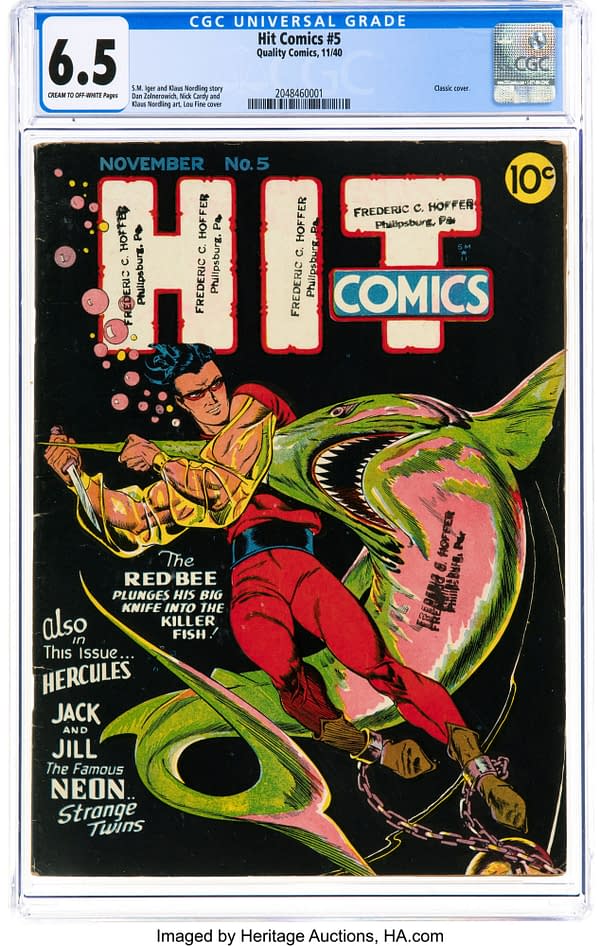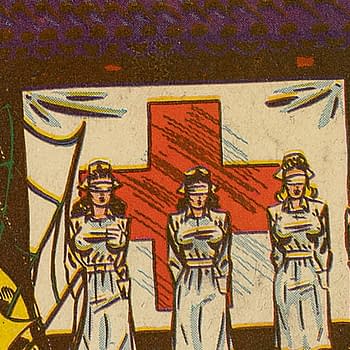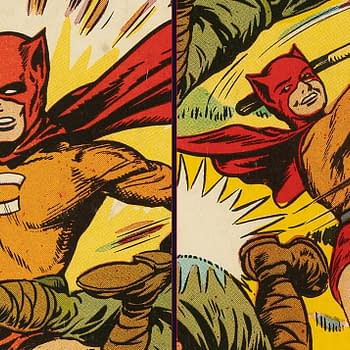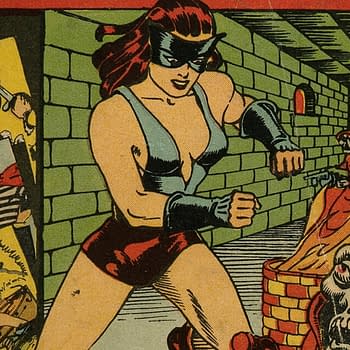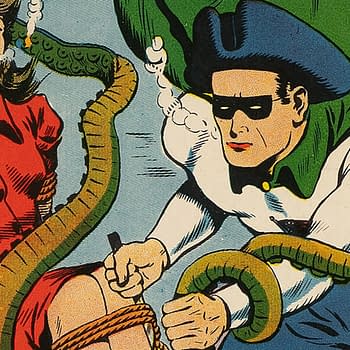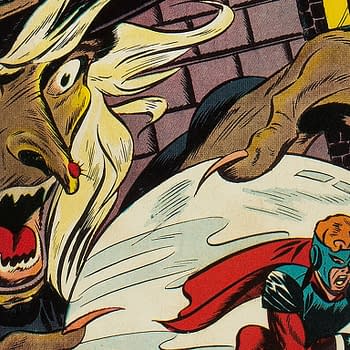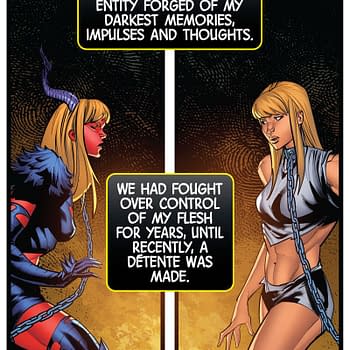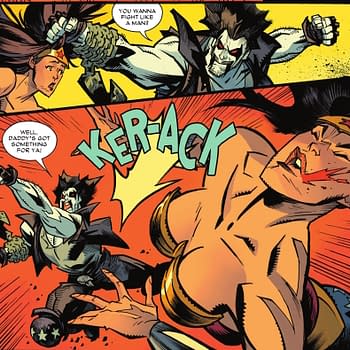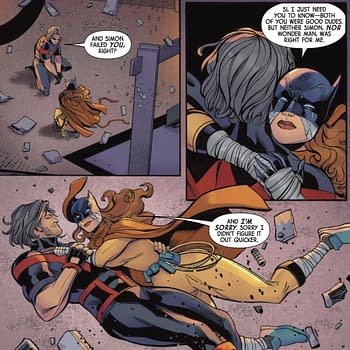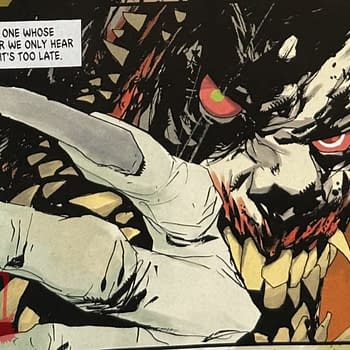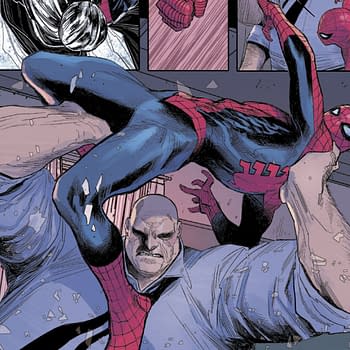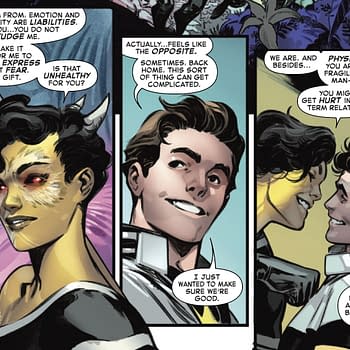Posted in: Comics, Heritage Sponsored, Vintage Paper | Tagged: golden age, lou fine, quality comics
Lou Fine's Iconic Work on Quality's Hit Comics #5, up for Auction
Lou Fine's iconic 1940 cover for Hit Comics #5 from Quality Comics is based on a scene from the interior story in that issue.
Article Summary
- Lou Fine's revered Golden Age artistry featured on Hit Comics #5.
- Toni Blum and Charles Wojtkoski's Red Bee debuted in Hit Comics #1.
- Hit Comics #5's cover is directly inspired by its story's scene.
- Fine's cover impact hints at Blum's influence on depicted events.
Despite working on and co-creating numerous characters now considered obscure, Lou Fine was considered one of the best artists of the Golden Age. He was an artist that even other comic book greats admired, and his cover work for publishers Fox Feature Syndicate, Fiction House, and Quality Comics is still highly regarded by collectors to this day. Will Eisner would once say about Fine, "I had respect for his towering kind of draftsmanship. He was the epitome of the honest draftsman. No fakery, no razzle-dazzle — very direct, very honest in his approach," while Joe Simon recalled, "My favorite artist was Lou Fine. He was also Jack Kirby's favorite artist. I know that Jack was a fan of and greatly influenced by Fine's work." Fine is credited with nearly 90 covers during the Golden Age by GCD, with many of them considered iconic by modern collectors.
The covers of comics like Planet Comics #1, Fantastic Comics #3, and Mystery Men Comics #3 are now the stuff of legend. The cover of Hit Comics #5 featuring the Red Bee is another highly-regarded classic and is arguably among his top 3 most famous and sought-after covers. An iconic cover by one of the most important artists of the Golden Age, there's a Hit Comics #5 (Quality, 1940) CGC FN+ 6.5 Cream to off-white pages up for auction in the 2024 May 30 Adventures in the Golden Age Comics Showcase Auction #40261 at Heritage Auctions.
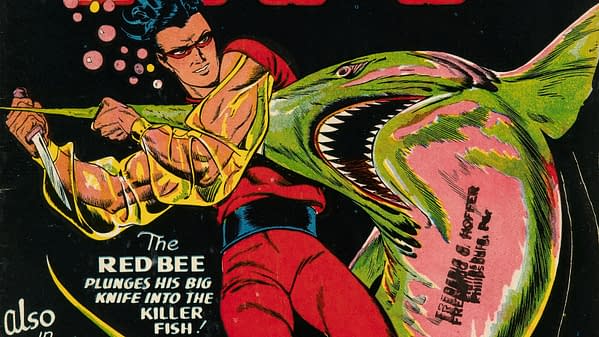
The Red Bee was the creation of Toni Blum and Charles Nicholas Wojtkoski for his debut in Hit Comics #1. The character was an Oregon-based assistant district attorney who got his name from his usage of trained bees that could be deployed from his belt buckle. Despite this strange beginning, or perhaps because of it, the character has not quite been forgotten. The Red Bee was alluded to in the 2014 comedy film She's Funny That Way. and also mentioned in the recent DCEU series Stargirl. DC Comics acquired the character in 1956 with the rest of the Quality Comics IP, although he has since entered the public domain.
Toni Blum (born Audrey Blum, January 11 1918 – 1973) began working for Eisner-Iger Studio around 1938, likely around the same time as her father, artist Alex Blum, joined the studio as well. Blum worked in comics for Eisner-Iger Studio (and later Iger Studio) through about 1943, though exact dates and credits are somewhat difficult to determine due to the number of pseudonyms she used. It's also known that she still had a hand in comics as late as 1956 at Gilberton. In addition to the Red Bee, her known contributions include Zero, the Ghost Detective in Quality's Feature Comics, Sally O'Neil Policewoman in National Comics, and Wonder Boy, also in National Comics. Blum married fellow Iger Studio artist William T. Bossert in 1942.
Charles Nicholas Wojtkoski (December 6, 1921 – June 21, 1985) is best remembered as the creator of the Blue Beetle. Wojtkoski worked for virtually every major publisher during his extensive career which lasted 1935-1984, during which he contributed to a staggering 3000+ comic books. His career includes a 23-year stint at Charlton, working with inker Vince Alascia and writer Joe Gill.
Interestingly, Fine's legendary cover on Hit Comics #5 is based on a scene from the interior story by Blum and Wojtkoski this issue. Red Bee had been captured by criminals who were using a boat as a base of operations and who dumped his bound, unconscious body into the waters of a nearby underwater aquarium. Contrary to what Fine implied on the cover, Red Bee is able to use the passing swordfish to cut through his bonds and escape the predicament.
It's possible that Toni Blum had a hand in the subject matter of this cover, and that this was not the only famous Lou Fine cover in which she played a role. An aspiring playwright, Blum was detail-oriented. According to Bossert in later years, Blum worked with artists by providing an outline and then advising them on page breakdowns and points of emphasis, noting "She'd write an outline, and she'd help [the artist] break it down page-by-page. Then she would get the pages back, and she would pencil in the actual dialogue on the page. Then the lettering man would letter the dialogue. … She'd say, 'This is supposed to be on the fifth page and you have it on the second page. You're giving away the whole story in the beginning.' So she had to re-do the whole story as it went along."
Will Eisner would also later note that "Toni Blum was an in-house writer and wrote for George Tuska, Jack Kirby and Lou Fine. There were only two rooms and little in the way of secrecy. People in the studio could hear what was going on in the front office if they cared to listen."
This all seems to imply that Blum may have been giving Fine suggestions on cover imagery for her own stories. As we've recently noted, Fine's legendary cover of Fantastic Comics #3 was based on a scene drawn by Toni Blum's father Alex Blum for Fantastic Comics #4. While the writing of that story has been tentatively attributed to Eisner, it seems possible that it was actually written by Toni Blum. By way of contrast, Fine's early Green Mask covers for Mystery Men Comics appear to have little to do with artist Walter Frame's interior stories.
The Red Bee is an obscure character elevated to collecting immortality by the cover artistry of Lou Fine, and there's a copy of his most famous cover appearance on Hit Comics #5 (Quality, 1940) CGC FN+ 6.5 Cream to off-white pages up for auction in the 2024 May 30 Adventures in the Golden Age Comics Showcase Auction #40261 at Heritage Auctions.
